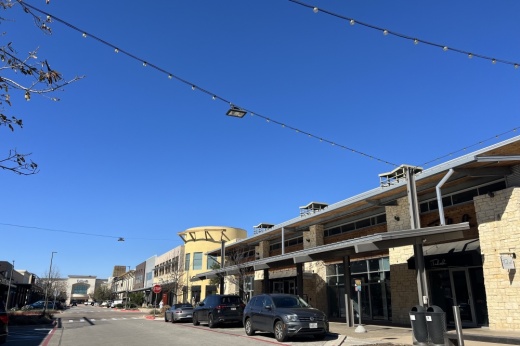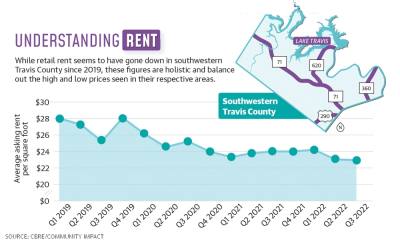However, after struggling to maintain his restaurant amid rising food costs and staffing issues, Haydostian closed R19 Taqueria at the end of December, just a year after opening.
“I don’t want to deter people from starting a business in Lakeway [or the immediate surrounding areas], but I do want to change how we do things around here, and I want other businesses to succeed,” he said.
The challenges Haydostian cited—along with inflation, rent rates and labor shortages—are similar to concerns plaguing other small-business owners in the Lake Travis and Westlake market as they head into 2023.
Small-business struggles
When it comes to opening and maintaining a business in the Lake Travis-Westlake area, several business owners told Community Impact they faced struggles that are distinctive to the region.
Area housing prices continue to rise, and houses priced at $750,000 or more comprise nearly three-quarters of the entire market, according to November data from the Austin Board of Realtors. As a result of the high cost of living, business owners told Community Impact it is a constant battle to hire, and keep, good employees.
Julian King, owner of Capriotti’s Sandwich Shop in Bee Cave, said he struggles to find staff to work the daytime shift.
“In order to live out here, you also need to make a very good salary, and you aren’t necessarily going to make that salary working at a sandwich shop,” King said.
Gabriel Chaparro is the co-owner and chef for MorninGlory, a new eatery that is set to open in Lakeway in the spring. One of his primary concerns is finding enough staff to open on time in March or April.
“I have heard about the hiring issues,” he said. “It’s just a nightmare in general everywhere, and I am kind of concerned about [hiring] being so far into Lakeway. I’m sure it’d be easier to staff closer to downtown.”
Along with staffing, the lack of transit continues to affect the market. Capital Metro, the bus and rail system that services much of Austin, does not have any transit options available along the sections of Hwy. 71 and RM 620 that go into Hill Country areas, such as Lakeway, Bee Cave and Spicewood. Some cities, such as Bee Cave, are taking the initiative in looking for solutions to the transportation dilemma. Beginning last fall, Bee Cave partnered with the Lake Travis Chamber of Commerce to help workers who commute more than 15 miles each way pay for gas through the holiday season, according to a press release from the city.
Other areas in the Lake Travis-Westlake market deal with similar, but also very different, obstacles in operating their businesses.
Lauren Frost, co-owner of Corrective Muscle Solutions, a physical fitness center in Spicewood, said the Lake Travis area has a “wonderful focus on health,” but that it also leads to a crowded marketplace. “It can be difficult to stand out and differentiate the services [we] offer,” she said.
Jeff Gotte, co-owner of Practical Fitness in West Lake Hills, said his company’s biggest challenge is increasing awareness of their studio and personal training services.
Barriers in the process
Additionally, several business owners, such as Haydostian, said they were having trouble understanding how to file permits with their municipality.
"The rules and regulations for starting a business [in Lakeway] are just different from surrounding areas,” Haydostian said. “The permitting process is very confusing.”
James Gatlin is a permit expeditor who has helped multiple businesses in Austin as well as Travis and Hays counties with their permitting processes. He said it can be difficult and time consuming for business owners, architects and designers to understand how to submit projects and permits with their city.
This can be especially true for businesses in smaller municipalities, such as Lakeway or Spicewood, he said.
Before the COVID-19 pandemic, the permitting process in Austin and surrounding cities was different, and business owners could meet with multiple departments at one time, making the process quicker, he said.
When local cities moved their permitting process online in 2020 and changed how they received proposed projects, it was a “major learning curve,” Gatlin said.
In Austin, when an owner or builder submits a project with energy, water, fire and all other required permits, it is done through one department, or all permits are submitted through one online portal, he said. However, in Lakeway, for example, the place to submit a fire permit and a plumbing permit are in two different parts of town, he said. A lack of coordination between these entities puts the burden on business owners and architects to navigate the process, he said.
This can delay construction and building deadlines if business owners do not know the permitting process in their city, he said.
“I had one client who had no idea these different organizations [within the city] don’t talk to each other,” Gatlin said.
In spite of any frustrations with the permitting process, Gatlin said there is “zero slowdown” in demand for commercial real estate in Lake Travis-Westlake.
“I am not slowing down [as a permitting processor], and my services are in demand. I haven’t seen any slowdown for commercial in these areas, despite inflation,” he said.
Driving demand
Even though small-business owners encounter obstacles when establishing roots in the area, demand in the Lake Travis-Westlake retail real estate market continues to grow, said John Heffington, retail real estate agent and first vice president for CBRE, a commercial real estate services firm.
The amount of people vying for retail space has rebounded since the pandemic, and even with respect to seasonal variation in the real estate market, Lake Travis-Westlake continues to serve as a highly sought area for business owners to lease space, Heffington said.
“When you look at where people choose to live in Austin, Westlake and Lake Travis are both extremely desirable areas, and ... retailers always like to follow where their customer base is,” Heffington said.
CBRE data breaks down by submarket, with southwest Travis County spanning from south of Lake Austin in the east to Spicewood in the west. The net space leased is the total amount of retail space put up for lease compared to the amount leased out. When more space is put up for lease than leased out, the market sees a positive number of net space leased, indicating market demand.
Compared to 2021, the net amount of square feet leased in the third quarter of 2022 was less than the previous year, but quarter three saw an overall gain compared to 2020 and 2019.
Another good indicator of market desirability is the occupancy rate, which is the amount of retail space leased, Heffington said. For southwestern Travis County, the occupancy rate has steadily risen in the past year, rising from 95.3% in the second quarter of 2021 to 97.4% in the third quarter of 2022.
“Typically as you see higher [net space leased], you see lower vacancies, and it’s supply and demand. Generally as you see less vacancy, you see rents go up,” Heffington said.
While rent has holistically gone down in the area for the past few years, according to the data, this is likely because some areas have lowered their rents in an attempt to fill vacancies, while other highly desired areas have continued to raise their rents, Heffington said.
“What we’ve seen in general with the neighborhoods and areas we’re talking about, we’ve actually seen rents increase,” Heffington said. “There’s probably a bit of [division] between the best retail centers and some of the smaller shopping centers, the centers that are unanchored or perhaps have greater age to them.”
Heffington also said the Lake Travis and Westlake market is not slowing down and said places in the Hill Country Galleria and Lakeway are growing more rapidly than Westlake.
Several business owners also told Community Impact they wanted to stay in the region. Frost said she and her husband have invested a lot of time in the Spicewood area and have built a reputation for Corrective Muscle Solutions.
“Fortunately, the Spicewood area has grown exponentially over the past few years. It’s created a lot of energy and momentum, and it’s an exciting time to be here,” she said.
Lake Travis-Westlake will continue to attract prospective business owners interested in the region because of the type of clients who live in the area, Heffington said.
“When you look at the amount of housing and the quality of housing being built out there, you are just going to continue to see quality products and quality tenants looking to relocate in these areas,” he said.










